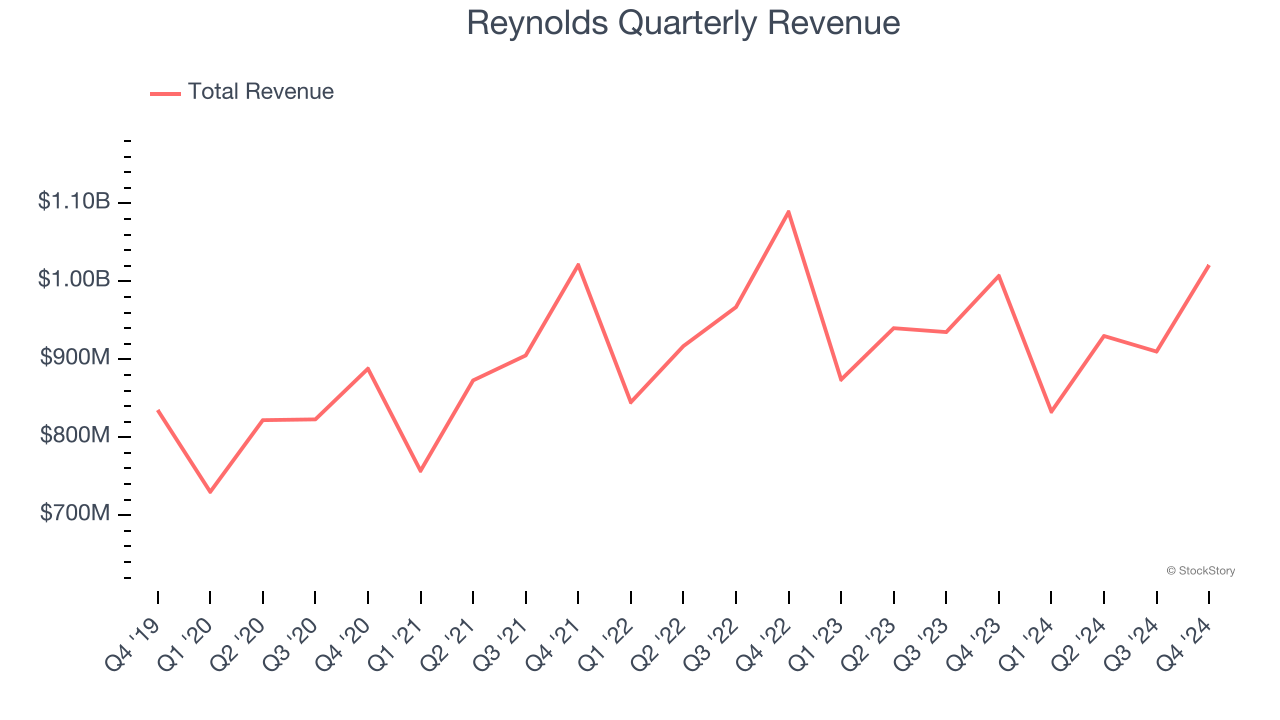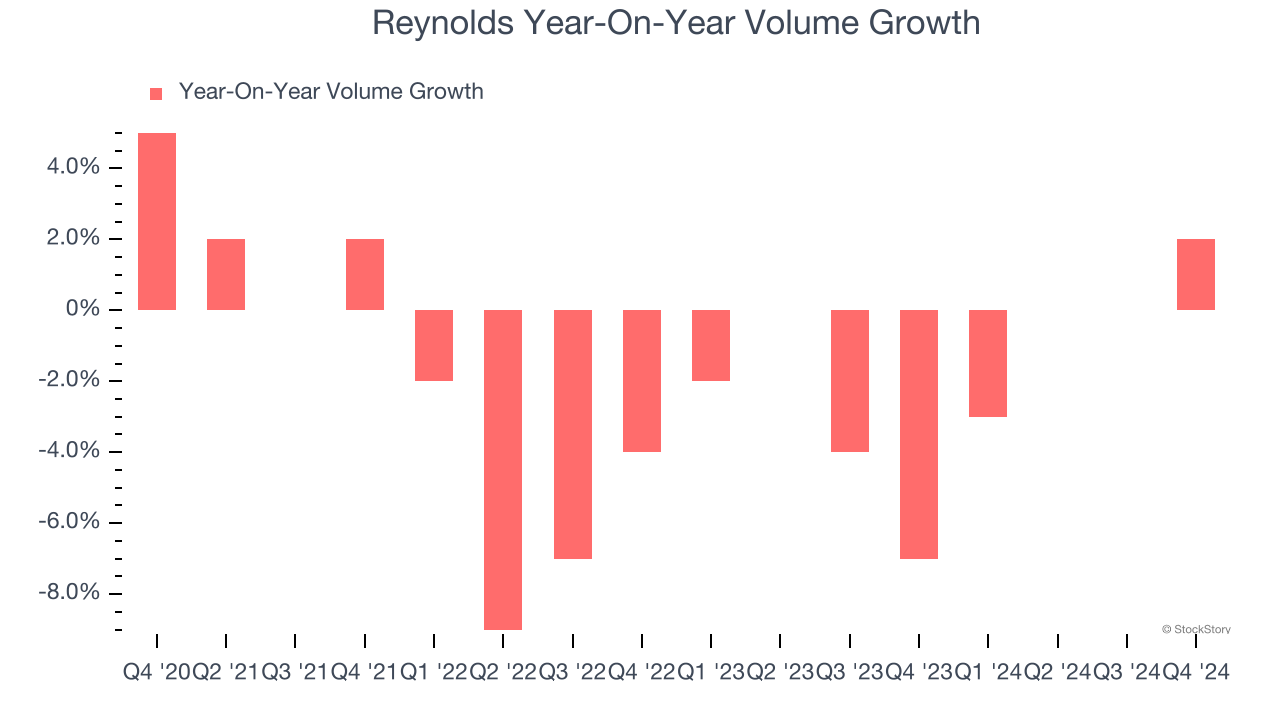
Household products company Reynolds (NASDAQ:REYN) reported Q4 CY2024 results beating Wall Street’s revenue expectations, with sales up 1.4% year on year to $1.02 billion. Its non-GAAP profit of $0.65 per share was 12.5% above analysts’ consensus estimates.
Is now the time to buy Reynolds? Find out by accessing our full research report, it’s free.
Reynolds (REYN) Q4 CY2024 Highlights:
- Revenue: $1.02 billion vs analyst estimates of $971 million (1.4% year-on-year growth, 5.2% beat)
- Adjusted EPS: $0.65 vs analyst estimates of $0.58 (12.5% beat)
- Adjusted EBITDA: $213 million vs analyst estimates of $214.4 million (20.9% margin, 0.6% miss)
- Adjusted EPS guidance for the upcoming financial year 2025 is $1.65 at the midpoint, missing analyst estimates by 6.6%
- EBITDA guidance for the upcoming financial year 2025 is $680 million at the midpoint, below analyst estimates of $702.7 million
- Operating Margin: 17.6%, down from 20.5% in the same quarter last year
- Free Cash Flow Margin: 13.8%, down from 19.3% in the same quarter last year
- Organic Revenue rose 1% year on year (-8% in the same quarter last year)
- Sales Volumes rose 2% year on year (-7% in the same quarter last year)
- Market Capitalization: $5.84 billion
“Our retail volume accelerated in the fourth quarter, and we have the team, business model and resources to drive strong growth, further margin expansion and consistently attractive shareholder returns,” said Scott Huckins, President and Chief Executive Officer.
Company Overview
Best known for its aluminum foil, Reynolds (NASDAQ:REYN) is a household products company whose products focus on food storage, cooking, and waste.
Household Products
Household products stocks are generally stable investments, as many of the industry's products are essential for a comfortable and functional living space. Recently, there's been a growing emphasis on eco-friendly and sustainable offerings, reflecting the evolving consumer preferences for environmentally conscious options. These trends can be double-edged swords that benefit companies who innovate quickly to take advantage of them and hurt companies that don't invest enough to meet consumers where they want to be with regards to trends.
Sales Growth
A company’s long-term performance is an indicator of its overall quality. While any business can experience short-term success, top-performing ones enjoy sustained growth for years.
With $3.69 billion in revenue over the past 12 months, Reynolds carries some recognizable products but is a mid-sized consumer staples company. Its size could bring disadvantages compared to larger competitors benefiting from better brand awareness and economies of scale.
As you can see below, Reynolds’s 1.3% annualized revenue growth over the last three years was weak as consumers bought less of its products. We’ll explore what this means in the "Volume Growth" section.

This quarter, Reynolds reported modest year-on-year revenue growth of 1.4% but beat Wall Street’s estimates by 5.2%.
Looking ahead, sell-side analysts expect revenue to remain flat over the next 12 months. This projection doesn't excite us and implies its newer products will not catalyze better top-line performance yet.
Today’s young investors won’t have read the timeless lessons in Gorilla Game: Picking Winners In High Technology because it was written more than 20 years ago when Microsoft and Apple were first establishing their supremacy. But if we apply the same principles, then enterprise software stocks leveraging their own generative AI capabilities may well be the Gorillas of the future. So, in that spirit, we are excited to present our Special Free Report on a profitable, fast-growing enterprise software stock that is already riding the automation wave and looking to catch the generative AI next.
Volume Growth
Revenue growth can be broken down into changes in price and volume (the number of units sold). While both are important, volume is the lifeblood of a successful staples business as there’s a ceiling to what consumers will pay for everyday goods; they can always trade down to non-branded products if the branded versions are too expensive.
To analyze whether Reynolds generated its growth (or lack thereof) from changes in price or volume, we can compare its volume growth to its organic revenue growth, which excludes non-fundamental impacts on company financials like mergers and currency fluctuations.
Over the last two years, Reynolds’s average quarterly volumes have shrunk by 1.7%. This isn’t ideal for a consumer staples company, where demand is typically stable. In the context of its 1.6% average organic sales declines, we can see that most of the company’s losses have come from fewer customers purchasing its products.

In Reynolds’s Q4 2024, sales volumes jumped 2% year on year. This result was a well-appreciated turnaround from its historical levels, showing the company is heading in the right direction.
Key Takeaways from Reynolds’s Q4 Results
Reynolds beat analysts’ organic revenue expectations this quarter, leading to a revenue beat. On the other hand, both its EPS and EBITDA guidance for the upcoming year fell short of Wall Street’s estimates. This outlook is weighing on shares. The stock traded down 3.1% to $27 immediately after reporting.
Is Reynolds an attractive investment opportunity right now? If you’re making that decision, you should consider the bigger picture of valuation, business qualities, as well as the latest earnings. We cover that in our actionable full research report which you can read here, it’s free.
